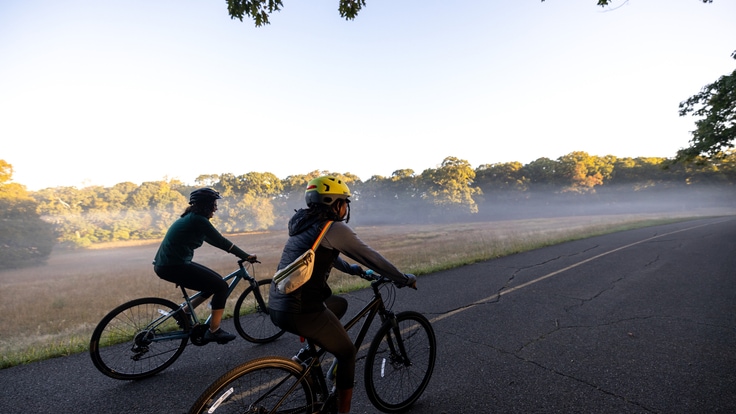Are you already dreaming about your first bike ride of the season—that first return to the saddle, with the legs stretching nicely and the breeze against your grinning face as you reacquaint yourself with a favorite route?
We are, too.
It's easy to glamorize that initial outing, though, and forget that those first rides may include some negatives: protesting squeaks from an unused bike, painful objections from too-quickly-tired quads and mid-ride frustration when you realize your bike bag contains only an expired goo packet and not the spare tube you need.
Thankfully, it's easy to avoid those frustrations and more serious problems with a bit of proper preparation. Here's our quick guide to getting your bike, your body and your gear ready for their best-ever inaugural ride of the season.
Prep your bike
How's your trusty, two-wheeled steed looking after months of hibernation? Chances are it needs a tune-up, or at least some fresh air in the tires and a quick wipe down. Whether you're a road rider, gravel grinder, mountain biker or you just plan to get out for around-town commuting, work through the following checklist before you roll out.
FYI: Many of the tips below are simple enough that a novice bike mechanic can undertake them, while others require a higher level of expertise. If you feel uncomfortable performing the following tasks, take your bike to an REI Bike Shop or another local bike shop. A tune-up is almost always cheaper, and definitely less painful, than a potential injury resulting from a broken bike.
Check the wheels
- Start out by looking over the tires. Inspect the tires' sidewalls to confirm there aren't any cracks or slits. If you notice either, replace the tire immediately.
- Properly inflate your tires. Inflate your tires so that the air pressure is within the manufacturer's suggested range. You can find the recommended tire pressure (PSI) on the sidewall of the tire.
- Check the tires' tread. Confirm they aren't worn out. If a tire is worn out on a road bike, it may look nearly squared off. Mountain- and gravel bikers might see a smoothed-out center tread compared to the bumpy sidewalls. Worn-out tires mean less traction and result in more frequent
flat tires. Save yourself the later hassle by instead buying a new tire now. - Refresh your tubeless tires. Riders who run tubeless tires will likely need to remove bits of old, dried-up sealant and add fresh bike tire sealant. If you're not running tubeless yet, the beginning of the season is a good time to make the switch. (Follow this tutorial on how to install tubeless tires.)
- Double-check your spokes. If you do find a problem, the spoke usually can be repaired without replacing the wheel.
Clean your bike
Wipe down the frame with a washcloth, water and mild dish soap to remove the dust, dirt and dried sweat (if you've been hammering on a trainer all winter). While doing this, keep an eye peeled for cracks, dings, dents or defects in the frame. If you see anything concerning, take the bike to a shop for an expert opinion.
Learn more: How to Clean a Bike
Clean the drivetrain
Run the chain against a dry rag to remove grit, which can wear down parts on your bike. (Pro tip: Avoid using a towel, which can leave fuzz behind on your chain.) For really dirty chains, you may want to clean the chain with a degreaser or even completely remove it from the bike and use a chain cleaning device. Then re-lube the chain. (For more detailed instructions, read How to Clean & Lube a Bike).
It's also a good idea to make sure last season's epic rides didn't wear out the chain. The chain's length should be within the manufacturer's specifications. You can measure this using a specialized tool like the Park Tool Chain Wear Indicator, or else a simple ruler.
Tighten the bolts
Both under- and over-tightened bolts may cause frustrating squeaks and/or dangerous riding conditions. Use a torque wrench (as opposed to a regular wrench) to tighten all bolts to the manufacturer's specifications. Don't forget harder-to-see bolts such as those beneath your bike seat.
Check your grips and saddle
Make sure both are in good condition, without rips or wear spots. If you're a road- or gravel cyclist, make sure the grip tape remains snug and has not come unraveled.
Test the front and rear lights
Batteries in your front and rear lights may have died over the winter. Re-charge them or replace them to ensure you're easy to see when on the road.
The following maintenance tasks will be easiest when done on a bike stand. If you don't have a bike stand you can also hang the bike from the nose of the saddle on a low-hanging branch or the edge of a workbench. Avoid turning the bike over and balancing it on the saddle. Doing so can rip the saddle, scuff the shifters and tear the grips.
Check the brakes
Are your front and rear brakes functioning properly? With the bike hanging from a bike stand, spin the front wheel and clamp down on the front brake. Make sure the front wheel stops. Then use your hand to rotate the pedal so the back wheel spins; apply the rear brake and make sure the rear wheel stops. Listen/watch to make sure the brake pads aren't rubbing the wheel as it spins.
Riders with hydraulic brakes: Make sure you feel a firm sensation when you apply the brakes. If you instead feel a squishy sensation, you may have air bubbles in the brake line. If so, your brakes need to be bled. You can do this yourself with a brake bleed kit. But if you're not confident in your ability to do this repair, consider taking your bike to a shop. Don't take chances with brakes. They're essential to safe riding.
Check the derailleur
With your bike still hanging from the bike stand, use one hand to turn the pedal and the other hand to shift through all the gears, up and down. As you shift, watch the chain to confirm that it jumps smoothly up or down to the next gear. If there's a delay between jumps or if you hear clicking coming from the chain as it tries and fails to catch the next gear, then the derailleur requires an adjustment. This can be done with a multi-tool, or you can take your bike into a shop.
Prep your body
The best way to prep your body for the spring biking season? Keep riding all winter long. (Here are some tips on Winter Cycling). Nearly all gyms and fitness centers are equipped with stationary bikes and may even offer indoor cycling classes.
If you'd rather sweat it out at home, invest in a bike trainer. Check out our handy guide for setting up your rig, and then peruse the numerous cycling app offerings to ensure you get in a great workout while keeping boredom at bay.
Fitness experts also recommend adding some strength training to the mix. In our overview How to Train for Cycling, contributing expert Samantha Van Gorder suggests a regimen of walking lunges, single-leg deadlifts and goblet squats to boost strength in the lower body. Pair those moves with stamina-building and balance-improving exercises such as planks and bridges to work the upper body and core.
Cardiovascular conditioning and flexibility training are also important pieces of the puzzle, especially if you plan to get out for multi-hour excursions this season. Our guide to training for endurance cycling offers month-by-month training plans, exercises, and stretches to get you ready.
Prep your gear
Finally, don't forget to give your gear an annual once-over as well.
Stock your bike bag or jersey pockets
Experts recommend that cyclists carry a handful of tools with them on every ride to fix smaller road- and trailside issues. Whether you pop them into a seat pack, stow them in a cycling hydration pack or simply stuff them into your bike jersey pockets, be sure to bring along the following:
- A spare tube
- A pair of tire levers
- An inflation device (either a hand pump or CO2 cartridges and inflator heads)
- A multi-tool.
It's also a good idea to have a quick-link on hand for chain repairs. On longer or harder rides you may want to bring a shifter cable; spare derailleur hanger; brake pads; zip ties; and additional spare tubes.
Check out our guide: Everyday Essentials to Keep You Rolling on the Trail.
Finally, add some new snacks to your stash. Double-check the expiration dates on whatever yummies still remain in your pack or pockets from last year. (Trust us on this one.).
Assess your apparel
That last ride of the season was likely cold, which probably means you just tossed the sweaty chamois in the laundry, threw the bike shoes in the closet and raced to the steaming shower. That's understandable, but it's all the more reason to take stock of what you wear before getting out this spring.
If you're riding clip-in shoes, examine their cleats. They might be beat up from pauses at stop lights or hike-a-bike sections of rocky trail. Often, that's fine. But if you find that your cleats disengage from the pedal too easily, even after tightening, it's a good sign it's time to replace them. Broken clasps may be simple fixes for your local cobbler.
Pay extra attention to the chamois on your bike shorts. If the padded section has become misshapen, with bunched up or thinner sections, or if the nylon is so worn out that it leaves little to the imagination, it's probably time to invest in a new pair of shorts. Small rips and tears in the shorts (especially mountain bike shorts) might be mendable with nylon repair tape.
Bike jerseys and jackets should last multiple seasons. Make sure the zippers still function and that they still fit appropriately. Your best fit will be whatever you feel most comfortable wearing. If you care about performance, go for a tighter, more aerodynamic fit.
Get more tips: What to Wear Bicycling.

